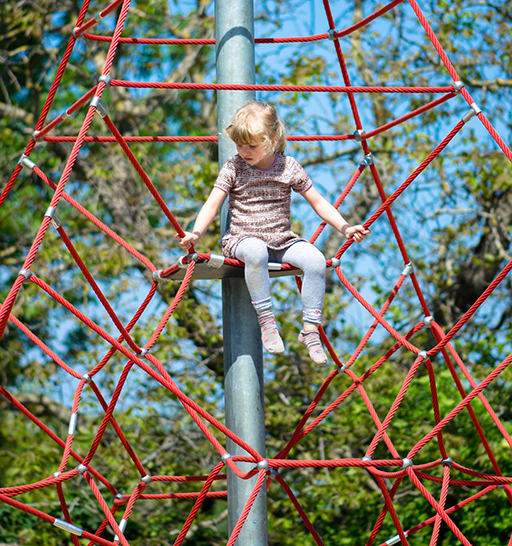4 Risky play
It is the role of adults to keep children safe and protect them from harm. Babies and young children should always be supervised, and adults must assess risk in relation to children’s stage of development.
Yet, there are concerns that in the last generation we have become a ‘risk-averse’ society and this has limited children’s opportunities to engage in physical and challenging play, especially in outdoor spaces. A survey by the National Trust in 2012 noted that more children are taken to hospital each year because they have fallen out of bed, than because they have fallen out of trees (Moss, 2012).
Supervising children whilst they engage in risky play can be an anxious time for parents or practitioners, who may tend to ‘err on the side of caution’. Yet, it is important to build children’s confidence, not their anxiety, and make sure we are not creating a culture of fear about physical play (Lindon, 2011).

The opportunity to take risks in physical play allows children to test their own limits and capabilities, although what is risky and challenging to one 3-year-old child, might be safe and easy for another. So, the factors that determine whether physical play is risky are very individual.
Risk and challenge go hand-in-hand in physical play. In Week 4, you looked at three definitions of ‘risky play’ that suggested risk involves some sort of hazard or perceived danger, for example, height, speed or uncertainty. Challenge refers to a situation in which a child can extend their own abilities or overcome fears (Solly, 2015).
All children need the opportunity to experience both risk and challenge in their play, many actively seek it out. They climb a little higher than before, jump off a higher step, go faster, try the slide backwards or ride a bike for the first time, for example. Some children may need the support of an adult when they first attempt one of these pursuits, and some children may occasionally need some very gentle and sensitive encouragement to attempt a challenging activity in which they perceive some risk.
However, allowing young children to encounter some risk in a supervised play environment enables them to develop crucial experience and skills for perceiving, assessing and managing risk or danger themselves.
Activity 3
Watch Video 2 which features Rose from a day nursery. Whilst you watch, think about Rose’s attitude and approach towards risky play in her setting.

Transcript: Video 2
[CHILDREN PLAYING]
[CHILDREN PLAYING]
Comment
Rose talks about taking a balanced approach to risky play. Rather than removing risks to protect children, she talks about supervising and monitoring play to enable children to challenge themselves and learn to assess and manage risk. Having a trusted adult there to support risky play enables children to stretch themselves physically.
